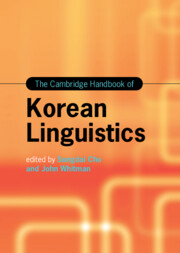Book contents
- The Cambridge Handbook of Korean Linguistics
- Cambridge Handbooks in Language and Linguistics
- The Cambridge Handbook of Korean Linguistics
- Copyright page
- Contents
- Figures
- Tables
- Contributors
- Preface
- Acknowledgments
- Abbreviations
- Part I Korean Overview
- Chapter 1 Introduction
- Chapter 2 Phonology: An Overview
- Chapter 3 Overview of Chapters on Syntax
- Chapter 4 On the Centrality of Korean in Language Contacts in Northeast Asia
- Chapter 5 Politeness Strategies in Korean
- Chapter 6 Korean Kugyŏl
- Part II Phonetics and Phonology
- Part III Morphology and Syntax
- Part IV Semantics and Pragmatics
- Part V Sociolinguistics and Psycholinguistics
- Part VI Language Pedagogy
- Index
- References
Chapter 3 - Overview of Chapters on Syntax
from Part I - Korean Overview
Published online by Cambridge University Press: 30 September 2022
- The Cambridge Handbook of Korean Linguistics
- Cambridge Handbooks in Language and Linguistics
- The Cambridge Handbook of Korean Linguistics
- Copyright page
- Contents
- Figures
- Tables
- Contributors
- Preface
- Acknowledgments
- Abbreviations
- Part I Korean Overview
- Chapter 1 Introduction
- Chapter 2 Phonology: An Overview
- Chapter 3 Overview of Chapters on Syntax
- Chapter 4 On the Centrality of Korean in Language Contacts in Northeast Asia
- Chapter 5 Politeness Strategies in Korean
- Chapter 6 Korean Kugyŏl
- Part II Phonetics and Phonology
- Part III Morphology and Syntax
- Part IV Semantics and Pragmatics
- Part V Sociolinguistics and Psycholinguistics
- Part VI Language Pedagogy
- Index
- References
Summary
Chapter 3 presents an overview of issues in Korean syntax. The specific chapters on syntax address topics that have received attention in both traditional and contemporary investigations of Korean (morpho) syntax, such as anaphora (Han) and nominalizations (Yoon), as well as some that have not previously been investigated in depth, such as Sino-Korean person-denoting nominals (Kim and Sells). The chapter on Right Dislocation (Ko) deals with a construction that received relatively little discussion in traditional or early generative analyses but has emerged as a central testing ground for contemporary debates on movement, ellipsis, and related issues. Finally, Kwon’s contribution deals with real-time processing of syntactic dependencies, which traditionally falls within the field of psycholinguistics. While the papers by Ko, Han, and Kwon are surveys, those by Kim and Sells, and Yoon are not, although the latter tries to situate the proposed analysis against the backdrop of longstanding debates in the analysis of lexical nominalizations in generative grammar. Overall, the collection of papers strikes a balance between familiar topics and newer, lesser-known, topics.
Keywords
Information
- Type
- Chapter
- Information
- The Cambridge Handbook of Korean Linguistics , pp. 63 - 81Publisher: Cambridge University PressPrint publication year: 2022
